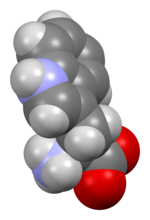An essential amino acid, or indispensable amino acid, is an amino acid that cannot be synthesized from scratch by the organism fast enough to supply its... 27 KB (2,690 words) - 16:06, 13 May 2024 |
 | nine essential amino acids for humans, accounting for 35% of the essential amino acids in muscle proteins and 40% of the preformed amino acids required... 29 KB (3,422 words) - 00:19, 18 March 2024 |
 | Amino acids are organic compounds that contain both amino and carboxylic acid functional groups. Although over 500 amino acids exist in nature, by far... 97 KB (10,074 words) - 22:06, 12 May 2024 |
 | An aromatic amino acid is an amino acid that includes an aromatic ring. Among the 20 standard amino acids, histidine, phenylalanine, tryptophan, tyrosine... 11 KB (1,066 words) - 00:23, 4 May 2024 |
Valine (redirect from 2-Amino-3-methylbutanoic acid) side chain isopropyl group, making it a non-polar aliphatic amino acid. Valine is essential in humans, meaning the body cannot synthesize it; it must be... 14 KB (1,152 words) - 11:04, 19 February 2024 |
 | Histidine (redirect from 2-Amino-3-(1H-imidazol-4-yl)propanoic acid) Histidine (symbol His or H) is an essential amino acid that is used in the biosynthesis of proteins. It contains an α-amino group (which is in the protonated... 24 KB (2,524 words) - 15:36, 26 April 2024 |
 | Methionine (redirect from 2-amino-4-(methylthio)butanoic acid) Met or M) (/mɪˈθaɪəniːn/) is an essential amino acid in humans. As the precursor of other non-essential amino acids such as cysteine and taurine, versatile... 29 KB (2,980 words) - 21:11, 23 March 2024 |
 | Phenylalanine (redirect from 2-Amino-3-phenylpropanoic acid) Phenylalanine (symbol Phe or F) is an essential α-amino acid with the formula C 9H 11NO 2. It can be viewed as a benzyl group substituted for the methyl... 28 KB (2,386 words) - 16:28, 30 March 2024 |
 | Lysine (redirect from Amino acid K) Lysine (symbol Lys or K) is an α-amino acid that is a precursor to many proteins. It contains an α-amino group (which is in the protonated −NH+3 form... 68 KB (7,502 words) - 20:02, 4 May 2024 |
Protein quality is the digestibility and quantity of essential amino acids for providing the proteins in correct ratios for human consumption. There are... 33 KB (1,786 words) - 16:59, 19 March 2024 |
Protein metabolism (redirect from Amino acid metabolism) code for a specific amino acid. Ribosomes translate the codons to their respective amino acids. In humans, non-essential amino acids are synthesized from... 27 KB (2,789 words) - 08:24, 26 March 2024 |
 | Leucine (redirect from 2-amino-4-methylpentanoic acid) or L) is an essential amino acid that is used in the biosynthesis of proteins. Leucine is an α-amino acid, meaning it contains an α-amino group (which... 27 KB (4,136 words) - 02:03, 6 April 2024 |
Essential amino acids (EAAs) are amino acids that are necessary to build proteins in an organism. The source of complete EAAs are both animal and plant-based... 6 KB (445 words) - 22:39, 7 December 2023 |
 | A ketogenic amino acid is an amino acid that can be degraded directly into acetyl-CoA, which is the precursor of ketone bodies and myelin, particularly... 7 KB (821 words) - 01:48, 26 March 2024 |
 | Threonine (redirect from 2-amino-3-hydroxybutanoic acid) chain containing a hydroxyl group, making it a polar, uncharged amino acid. It is essential in humans, meaning the body cannot synthesize it: it must be... 16 KB (1,364 words) - 03:58, 15 April 2024 |
Complete protein (section Amino acid profile) protein that contains an adequate proportion of each of the nine essential amino acids necessary in the human diet. People who eat a varied diet generally... 6 KB (471 words) - 17:09, 13 May 2024 |
digestibility-corrected amino acid score (PDCAAS) is a method of evaluating the quality of a protein based on both the amino acid requirements of humans... 15 KB (1,700 words) - 14:38, 5 May 2024 |
 | Tryptophan (redirect from (2S)-2-amino-3-(1H-indol-3-yl)propanoic acid) tryptophan: they need to obtain it through their diet, making it an essential amino acid. In 2023, the emission spectrum of tryptophan was discovered in the... 46 KB (4,561 words) - 11:12, 1 March 2024 |
vegetarian and vegan diets may provide an insufficient amount of some essential amino acids, making protein combining with multiple foods necessary to obtain... 20 KB (2,525 words) - 02:36, 20 April 2024 |
 | 8 or 9 essential amino acids. The consensus seems to lean towards 9 since histidine is not synthesized in adults. There are five amino acids which humans... 46 KB (5,048 words) - 04:56, 23 April 2024 |
 | Taurine (redirect from 2-aminoethanesulfonic acid) Taurine (/ˈtɔːriːn/), or 2-aminoethanesulfonic acid, is a non-proteinogenic naturally occurred amino sulfonic acid that is widely distributed in animal tissues... 27 KB (2,875 words) - 18:12, 16 April 2024 |
 | Tyrosine (redirect from 2-amino-3-(4-hydroxyphenyl)propanoic acid) is one of the 20 standard amino acids that are used by cells to synthesize proteins. It is a non-essential amino acid with a polar side group. The... 26 KB (2,535 words) - 18:40, 19 April 2024 |
 | Isoleucine (category Essential amino acids) branched-chain, aliphatic amino acid. It is essential in humans, meaning the body cannot synthesize it. Essential amino acids are necessary in the human... 15 KB (1,403 words) - 23:32, 3 April 2024 |
Proline (category Alpha-Amino acids) it as a aliphatic amino acid. It is non-essential in humans, meaning the body can synthesize it from the non-essential amino acid L-glutamate. It is... 23 KB (2,241 words) - 04:41, 26 April 2024 |
two fatty acids are known to be essential for humans: alpha-linolenic acid (an omega-3 fatty acid) and linoleic acid (an omega-6 fatty acid). These are... 23 KB (2,883 words) - 03:53, 9 April 2024 |
 | Glutamic acid (symbol Glu or E; the anionic form is known as glutamate) is an α-amino acid that is used by almost all living beings in the biosynthesis... 35 KB (3,213 words) - 17:05, 8 May 2024 |



